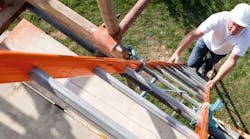More than 90,000 people receive emergency room treatment for ladder-related injuries every year, according to www.osha.gov. Deaths due to falling from elevation account for 15% of occupational deaths, and ladders figure prominently in that percentage. The problem is not the ladders themselves, however. OSHA has repeatedly said that, based on years of incident reports, 100% of ladder-related deaths are preventable.
Half of those deaths result from carrying something up the ladder. We’ll look at how to prevent the other 50%, but first let’s address this cause of death because so many people insist on taking the risk.
Preventing “carries”
You can prevent the carrying problem through job planning and having the necessary equipment to raise parts, tools, and materials to the work elevation. Carrying brings extreme risk of extreme pain. The consequences of falling off a ladder because you “thought” you could safely carry something up can include broken bones, spinal injuries that cause permanent loss of mobility, or, as OSHA has made clear, death.
The sheer number of deaths, disfigurements, and other nasty consequences of falling because of trying to carry something up a ladder tells us that too many people can’t see why it’s a problem until it’s too late.
After all, you have both feet on the rungs, and you can hold on with one hand. That “after all” is true for a static situation. You can stand on a rung and balance while holding a drill. But two things happen. The more obvious of the two is you have only one hand available for moving up the ladder. This has balance implications, which we will address in a moment.
The less obvious consequence is that carrying an object in front of you requires a counterbalance; you must shift your weight. So, your hips will roll slightly backward, which is away from the ladder. As you move up the ladder, the balance you created by that hip roll is precarious because your center of gravity is moving as your base of support changes.
Having only one hand available for holding on vastly increases your chances of a fall. If you’re holding a drill in your left hand while trying to climb a ladder, for example, you will be off balance every time you bring your left foot up. If you move your right hand to the center instead of the right side to compensate, then your base of support becomes narrower — and much of your mass is outside that base. Yet, you need to get that drill up the ladder. How can you safely accomplish that?
At one time, roofers carried shingles up a ladder by placing a 90-lb bundle on each shoulder. This maintained balance, but was physically challenging. Today, roofing companies use an escalator to put shingles on the roof. Lifting devices for the kind of work you do are available; contact your electrical distributor.
Another option is to go “low tech.” For example, use a “tag” line. Affix a thin rope to your belt or harness. Once you get to your working position, affix one end of the rope to a secure point, and lower the other end. Your assistant then ties the rope to a bucket. You pull the rope to raise the bucket. A variation is to use a bucket for parts, but tie any big tool (e.g., a drill) directly to the rope.
If you’re not up very high, then the person on the ground can simply hand you things — like that fluorescent lamp you were smart enough not to carry up the ladder.
Never carry something up with your “free hand” because you don’t have a free hand. The balance challenge puts both your climbing skill and your luck on the edge of failure every time. OSHA has the death and injury reports to prove it.
Ladder selection
Ladder safety begins with choosing the right ladder for the job and ensuring it’s safe to use. How do you conduct a safety inspection before using a ladder? First, remove grease, mud, oil, or other slip hazards. Next, look for protruding rivets, loose steps or rungs, cracks in the side rails, or other mechanical damage. If you see any of these, mark that ladder for disposal, and get a different one.
Don’t use an aluminum ladder; the conductive rails pose a shock hazard. Fiberglass ladders are the standard today, although unpainted wooden ladders are also suitable for electrical work. If a ladder is painted (or even has paint spatters), don’t use it. The paint is conductive and probably a slip hazard.
The ladder must be tall enough for the job. Many injuries happen due to “short ladder syndrome.” One “solution” is to place the ladder on top of inverted buckets or some other unstable platform. Another “solution” is to climb past the “don’t climb past here” rung of the ladder. The only correct solution is to get a tall enough ladder for the job.
Check the weight rating. This isn’t the weight of you in your skivvies, it’s the total weight on the ladder including your boots and other gear you’re wearing (such as that heavy tool pouch). Err on the side of caution. If you might be getting close to the limit, get a different ladder.
Use a ladder foot type suitable for the surface. For example, on a smooth tile floor the feet should have a soft non-slip material such as butyl or rubber. On a grassy surface, you’d want feet with treads or spurs. Some ladders have changeable feet, some don’t. If you can’t change the feet, then change the ladder.
The materials of a ladder undergo stress from use — that is, ladders weaken over time. If you don’t know the age or usage history of the ladder, it probably should be replaced. Look at the brand label, and contact the manufacturer; it may have a way to at least identify the year the ladder was built.
Ladder usage
Carefully position the ladder. Place it on a firm, level surface. You may have to dig down into gravel or dirt to get stability. Where appropriate, use foot stakes to prevent slippage. Don’t put your ladder in front of a door that someone might open. If you don’t have an assistant to guard the door — or you can’t lock or block it — move the ladder.
A slipping hazard on a rung means a falling hazard. Don’t hang anything on a ladder rung.
Maintain three points of contact with the ladder to ensure stability. Note: This is impossible if you are carrying something up the ladder. Use the steps, not the cross braces, to support your weight.
Do not lean to reach laterally; this moves your center of gravity outside your base of support. Instead, climb down and re-position the ladder.
Only one person at a time on a ladder, unless some emergency provides a reason for two. For example, someone has a heart attack and slumps over; someone else might climb up to get him. But observe the weight limit! You don’t want that rescue attempt to result in a fatal fall for both people.
Step ladder safety
• Check the cross bracing for mechanical damage.
• Check the feet to ensure they are undamaged and properly attached.
• Lock the hinges before setting the ladder.
• Do not stand on the second step from the top (or on anything marked “not a step”).
• Before moving the ladder, look on the top and (if present) tool tray to ensure nothing will fall off.
Extension ladder safety
• Keep hands away from moving parts when operating the extension mechanism.
• Position the ladder one foot out at the base for every four feet of vertical distance. That angle will use the weight of you and your ladder to improve stability.
• Extend the ladder three feet above the top of a structure or excavation.
• Where practical, secure the ladder by tying it off at the top and then tie or wedge it near the bottom.
No falls
Ladder falls don’t have to happen. Take precautions to prevent ladder movement when setting up the ladder. Plan the job to minimize up and down trips, and when making those trips use your hands for climbing, not carrying things. When you’re on a ladder, remember that using it is a balancing act. Try to stay centered on the ladder rather than leaning back or to one side.
Lamendola is an electrical consultant located in Merriam, Kan. He can be reached at [email protected].




